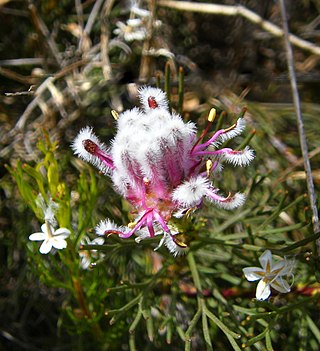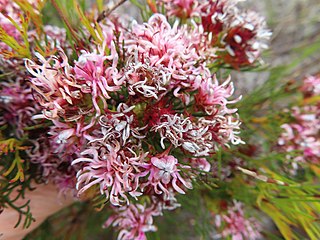
Serruria aitonii, the marshmallow spiderhead, is a flower-bearing shrub that belongs to the genus Serruria and forms part of the fynbos. The plant is native to the Western Cape and occurs from the Cederberg and Sandveld to the Groot-Winterhoek Mountains and Piketberg. The shrub is round and grows 1.0 m tall and flowers from July to November.
Serruria altiscapa, the stately spiderhead, is a flower-bearing shrub that belongs to the genus Serruria and forms part of the fynbos. The plant is native to the Western Cape and occurs at Blokkop in Villiersdorp as far as the Hottentots-Holland Mountains.

Serruria furcellata, the Kraaifontein spiderhead, is a flower-bearing shrub that belongs to the genus Serruria and forms part of the fynbos. The plant is native to the Western Cape, it has always been found at Brackenfell, Kraaifontein and Kuils River.

Serruria decipiens, the Sandveld spiderhead, is a flower-bearing shrub that belongs to the genus Serruria. It forms part of the fynbos biome. The plant is native to the Western Cape, where it only occurs on the Sandveld, Hopefield, the Cape Flats, Piketberg, and Olifants River Mountains. The shrub is round and grows 1.0 m tall and bears flowers from July to October.

Serruria phylicoides, the bearded spiderhead, is a flower-bearing shrub that belongs to the genus Serruria and forms part of the fynbos. The plant is native to the Western Cape, where it occurs in the Du Toits Peak, the Hottentots Holland Mountains, the Riviersonderend Mountains and the Kleinrivier Mountains. The shrub grows 1.0 m tall and bears flowers from August to November.

Serruria fucifolia, the northern spiderhead, is a flower-bearing shrub that belongs to the genus Serruria and forms part of the fynbos. The plant is native to the Western Cape, South Africa.

Serruria brownii, the bottlebrush spiderhead, is a flower-bearing shrub that belongs to the family Proteaceae and forms part of the fynbos. The plant is native to the Western Cape, South Africa.
Serruria candicans, the shiny spiderhead, is a flower-bearing shrub that belongs to the genus Serruria and forms part of the fynbos. The plant is native to the Western Cape, where it occurs from Elandskloof to the Slanghoek Mountains and Paardeberg at Malmesbury. The shrub is erect and grows only 80 cm tall and bears flowers from July to December.
Serruria cyanoides, the Wynberg spiderhead, is a flower-bearing shrub that belongs to the genus Serruria and forms part of the fynbos.

Serruria bolusii, the Agulhas spiderhead, is a flower-bearing shrub that belongs to the genus Serruria and forms part of the fynbos. The plant is native to the Western Cape and is found in Elim hills and Soetanysberg. The shrub grows upright to 1.0 m tall and flowers from August to December.

Serruria villosa, the golden spiderhead, is a flower-bearing shrub that belongs to the genus Serruria and forms part of the fynbos. The plant is native to the Western Cape, where it occurs only on the Cape Peninsula and just south of Constantia. The shrub is erect and grows only 50 cm tall and bears flowers from April to July.

Serruria heterophylla, the spindly spiderhead, is a flower-bearing shrub that belongs to the genus Serruria and forms part of the fynbos. The plant is native to the Western Cape and occurs near Kleinmond and the Klein River Mountains. The shrub grows erect, grows 1.0 m tall and flowers from July to October.

Serruria stellata, the star spiderhead, is a flower-bearing shrub that belongs to the genus Serruria and forms part of the fynbos. The plant is native to the Western Cape, South Africa.
Serruria confragosa, the wavy spiderhead, is a flower-bearing shrub that belongs to the genus Serruria and forms part of the fynbos. The plant is native to the Western Cape and occurs in the Koue Bokkeveld Mountains and Great Winterhoek Mountains. The shrub grows upright with few branches and grows 1.0 m tall, and flowers from September to November.
Serruria zeyheri, the matchstick spiderbush, is a flowering shrub that belongs to the genus Serruria and forms part of the fynbos. The plant is endemic to the Western Cape and occurs from the Du Toitskloof Mountains to the Riviersonderend Mountains, possibly also in the Greenland Mountain. The shrub is upright and grows 50 cm high and flowers from August to November.
Serruria dodii, the Hex River spiderhead, is a flowering shrub that belongs to the genus Serruria and forms part of the fynbos. The plant is endemic to the Western Cape and occurs in the Hex River Mountains and Keeromsberg. The shrub grows upright, reaches a height of 1.0 m and flowers from August to November.

Serruria effusa, the candelabra spiderhead, is a flowering shrub that belongs to the genus Serruria and forms part of the fynbos. The plant is endemic to the Western Cape, where it occurs in the Olifants River Mountains and the Sederberg. The shrub is upright with a diameter of 1.5 m, one grows to 1.5 m high and bears flowers from August to September.

Serruria meisneriana, the dainty spiderhead, is a flowering shrub that belongs to the genus Serruria and forms part of the fynbos. The plant is endemic to the Western Cape and occurs in the north-east Babylon Tower and Greenland Mountains. The shrub is slender and grows to 50 cm high and flowers from July to October
Serruria millefolia, the millileaf spiderhead, is a flowering shrub that belongs to the genus Serruria and forms part of the fynbos. The plant is endemic to the Western Cape and occurs in the Sandveld from the Bokkeveld Mountains escarpment to the Olifants River Mountains. The shrub grows upright, only 50 cm high and flowers from August to December

Serruria reflexa, the milky spiderhead, is a flowering shrub that belongs to the genus Serruria and forms part of the fynbos. The plant is endemic to the Western Cape and occurs from the Koue Bokkeveld to the Olifants River Mountains between The Baths and Porterville. The shrub grows erect, reaches 2.0 m in height and flowers from September to November.














